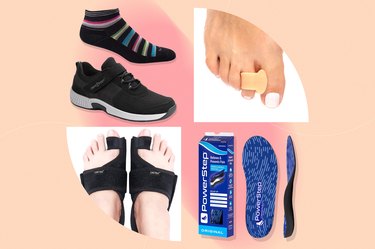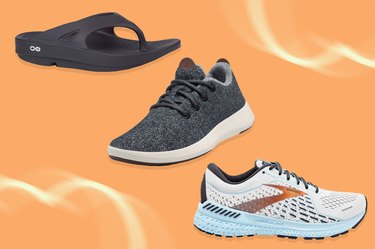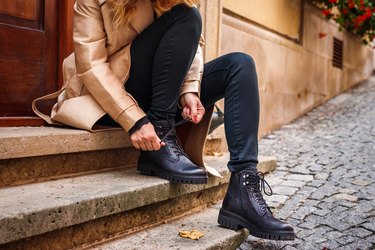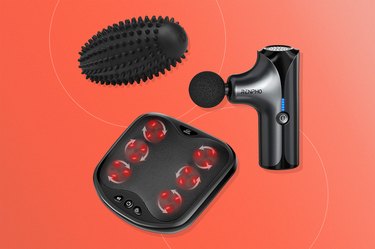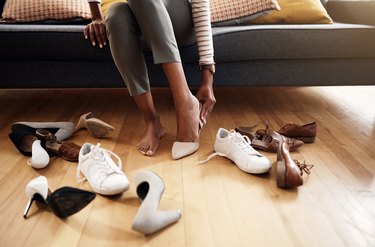
Bunions don't typically pop up on your feet overnight. So if you notice one is starting to form — or want to take steps to steer clear completely — what should you do?
Bunions are bony bumps that form on the side of the foot, near the base of the big toe. They're often red and swollen and can cause soreness, pain or even numbness around the big toe. In some cases, bunions can even make it harder to find comfortable-fitting shoes and can increase the risk for other foot problems like hammertoes, per the Cleveland Clinic.
Video of the Day
Video of the Day
These annoying bulges tend to develop slowly, so it can be hard to spot a bunion until it's already big and uncomfortable. The good news? Knowing where bunions come from can help you take steps to reduce your risk of getting one, and maybe even nip a developing bunion in the bud.
Here are six common causes of bunions and how to prevent bunions from getting worse.
1. Family History
If a parent or sibling deals with bunions, you're more likely to get them as well.
In fact, 70 percent of people who develop bunions have a family history, according to the American Academy of Orthopaedic Surgeons (AAOS).
2. Flat Feet
Your chances for developing bunions go up if you have flat feet.
"If an individual has flat feet, this causes their foot to pronate and their arch to collapse. Over time, walking this way can push the big toe out of alignment, thus forming a bunion," explains Steven Neufeld, MD, foot and ankle specialist for The Centers for Advanced Orthopaedics.
3. Ill-Fitting Shoes
Shoes with narrow toes or high heels don't cause bunions. But if you're already prone, regularly wearing them can trigger a bunion to develop, according to Harvard Health Publishing.
"If someone is constantly squeezing their toes into a high heel with a narrow toe box or an ill-fitting shoe, their toes are being pushed together and the ligaments that would normally hold the toes straight are stretched," says Dr. Neufeld.
Over the course of many years, this can cause a bunion to form.
4. Pregnancy
Hormones released during pregnancy can loosen ligaments in the feet and cause feet to become flatter, per March 2014 findings in the American Journal of Physical Medicine & Rehabilitation.
That can lead to the development of bunions, either during a pregnancy or afterwards.
5. Rheumatoid Arthritis
Rheumatoid arthritis that isn't well managed can up the risk for bunions. As the disease progresses, the body attacks the lining, capsule and ligaments around the joints.
"This weakens the soft tissues that stabilize the joint, so the tendons are no longer balanced and the big toe can be pushed into different positions," Dr. Neufeld explains.
He points out, though, that RA shouldn't cause bunions if medications are adequately controlling a person's symptoms.
6. Foot Injuries
Foot injuries don't often lead to bunions, but they can.
"Any injury that damages the big toe joint, like a fracture or sprain, can potentially cause the toe to deviate and become crooked, forming a bunion," says Dr. Neufeld.
A bunion is most likely to form if the injury doesn't heal correctly or heals in a crooked position.
How Bunions Are Treated
Bunions can't always be prevented. But it's worth taking steps to keep the problem from getting worse if you notice a bunion forming or have a bunion that's starting to cause discomfort. Over time, bunion pain can cause you to be more sedentary and lead to other foot problems like hammertoe, the Cleveland Clinic notes.
You can manage bunions and soothe your sore feet by doing the following:
- Wear comfortable shoes that fit. Shoes with a wide, flexible sole and wide toe box won't squeeze your toes. If you opt for heels, keep them under an inch, recommends Harvard Health Publishing.
- Try a bunion pad. Moleskin or gel-filled pads can cushion your bunion, reducing irritation when you wear shoes.
- Get fitted for orthotics. Custom-made shoe inserts can give flat arches more support, which can help reduce bunion discomfort, says Suzanne Levine, DPM, a podiatrist with Millennium Podiatry.
- Take anti-inflammatory measures. A warm soak with Epsom salts can help reduce inflammation and revive tired feet, Dr. Levine says. Over-the-counter anti-inflammatory drugs like aspirin or ibuprofen can help too.
- Go to physical therapy. Foot massages or exercises can reduce pain and inflammation as well as strengthen the muscles around the bunion, which may help improve toe alignment, the Cleveland Clinic notes.
- Consider steroid injections. These may reduce pain and swelling for severe bunions. Ask your doctor if they're right for you.
- Ask about surgery. In some cases, a bunionectomy may be needed to remove a large, painful bunion and help bring the toes back into alignment. "I treat my patients using minimally invasive techniques to correct the bunion deformity which results in easier, faster and less painful recoveries," Dr. Neufeld says.
When to See a Doctor for Bunions
Bunions most often don't require medical treatment, but treatment can reduce your discomfort and reduce the risk for additional foot problems like hammertoe, per the Mayo Clinic.
See a podiatrist or foot and ankle specialist if your bunion is uncomfortable, if it's making it hard to find comfortable shoes or if it's affecting your daily life, recommend Drs. Levine and Neufeld.
Was this article helpful?
150 Characters Max
0/150
Thank you for sharing!
Thank you for your feedback!
Is this an emergency? If you are experiencing serious medical symptoms, please see the National Library of Medicine’s list of signs you need emergency medical attention or call 911.
